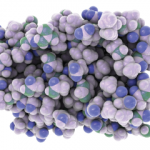Although all the endosomal TLRs are trafficked by UNC93B1, notable differences exist, he said. TLR 7 seems to be more pathogenic than the others, possibly due to increased signaling, and evidence shows that TLR 8 and 9 may be protective.
“How do we avoid recognition of self-nucleic acids? Is it really complete avoidance of recognition by a normal individual, or perhaps there is some recognition of a low grade that may be important for the priming of the immune system. We do not know,” he said. “But the absence of disease-promoting recognition is thought to be due to the intracellular sequestration of these nucleic acid sensors, effects of nucleases, and other processes.”
“In autoimmunity, there may be an oversupply of self-nucleic acids due to increased apoptosis, necrosis or NETosis. There may be defective clearance, such as defects in scavenger receptors that remove apoptotic or necrotic materials, as well. If these processes don’t work properly, autoimmunity could be the result,” he said.
“So there are processes whereby we may avoid recognition, and there are circumstances where these barriers are broken, and then autoimmune disease might be the consequence,” he said. Cytosolic sensors may play a role too, because specific mutations of RIG-I or MDA-5 (IFIH1), and defects in nucleases like TREX-1 and RNASEH2, and certain signaling molecules (STING) promote development of syndromes called interferonopathies.
“These diseases are very peculiar. They’re not necessarily lupus, although occasionally, but very rarely, classical lupus patients may have mutations in the genes that induce these interferonopathies,” he said. “Only about 500 families in the world have been identified that have the TREX1 mutation for Aicardi Goutieres syndrome or chilblain lupus.
“Thus, lupus and autoinflammatory syndromes have stimulated efforts to develop targeted therapies, and clinical trials have been initiated, including IFNAR antibody (anifrolumab), IFN-Kinoid, anti-TLR7, bortezomib and JAK-kinase inhibitors. Inhibitors of SLC15A4 may also be considered.”
Research in these areas is ongoing at his laboratory, he added.
Susan Bernstein is a freelance journalist based in Atlanta.
References
- Theofilopoulos AN, Gonzalez-Quintial R, Lawson BR, et al. Sensors of the innate immune system: Their link to rheumatic diseases. Nat Rev Rheumatol. 2010 Mar;6(3):146–156.
- Crow MK. Type I interferon in the pathogenesis of lupus. J Immunol. 2014 Jun;192(12):5459–5468.
- Santiago-Raber ML, Baccala R, Haraldsson KM, et al. Type-1 interferon receptor deficiency reduces lupus-like disease in NZB mice. J Exp Med. 2003 Mar;197(6):777.
- Baccala R, Gonzalez-Quintial R, Schreiber RD, et al. Anti-IFN-αβ receptor antibody treatment ameliorates disease in lupus-predisposed mice. J Immunol. 2012;189:5976–5984.
- Tabeta K, Hoebe K, Janssen EM, et al. The UNC93B1 mutation 3d disrupts exogenous antigen presentation and signaling via toll-like receptors 3, 7 and 9. Nat Immunol. 2006 Jan;7:156–164.
- Koh YT, Scatizzi JC, Gahad JD, et al. Role of nucleic-acid sensing TLRs in diverse autoantibody specificities and antinuclear antibody-producing B cells. J Immunol. 2013 May;190(10):4982–4990.
- Baccala R, Gonzalez-Quintial R, Blasius AL, et al. Essential requirement for IRF8 and SLC15a4 indicates plasmacytoid dendritic cells in the pathogenesis of lupus. PNAS. 2013 Feb;110(8):2940–2945.
- Theofilopoulos AN, Kono DH, Baccala R. The multiple pathways to autoimmunity. Nat Immunol. 2017;18:716–724.


